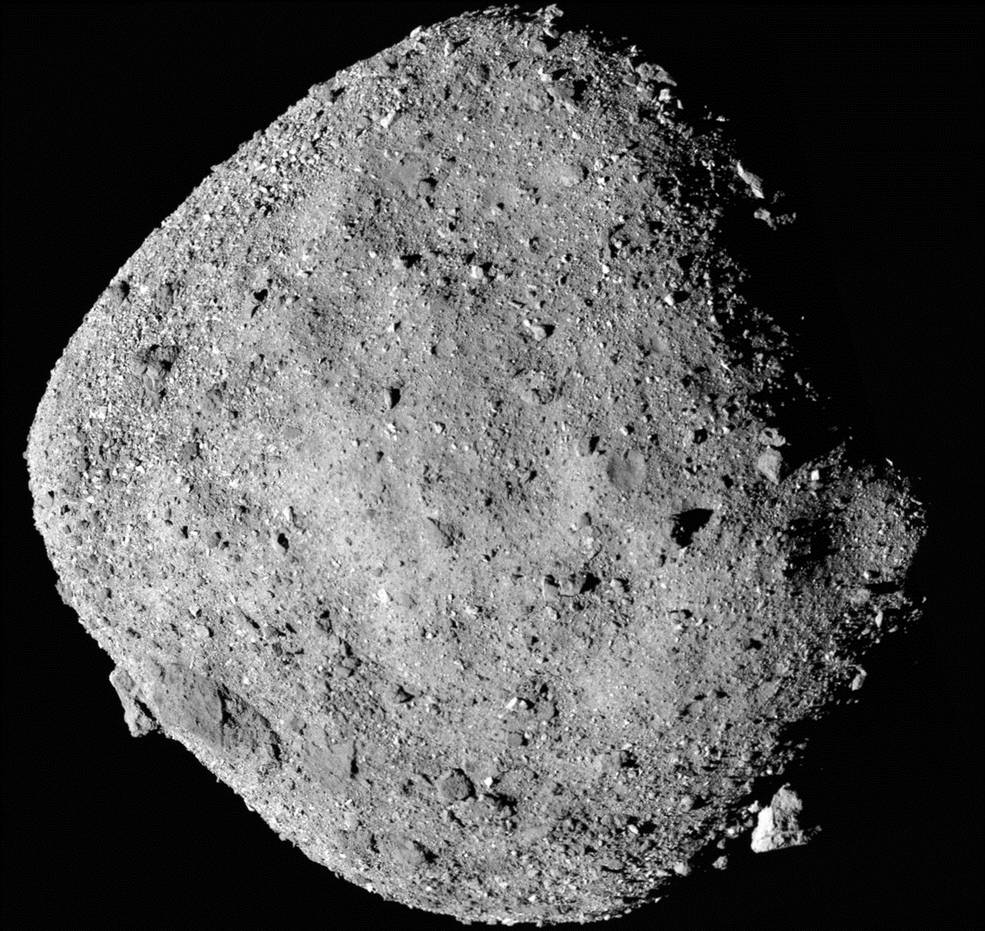NASA's OSIRIS-REx (Origins, Spectral Interpretation, Resource Identification, Security-Regolith Explorer) has found water on the asteroid Bennu.
Bennu
is OSIRIS-REx's only target, and though the spacecraft arrived at the asteroid on December 3rd, some of its instruments have been trained on the asteroid since mid-August. And two of those instruments detected water on Bennu.
OSIRIS-REx wasn't sent to Bennu just to find water. The mission is NASA's first asteroid sample-return mission. The presence of water on Bennu confirms what the science team hoped would be true when they selected the asteroid as the spacecraft's destination: Bennu is an excellent target for scientific inquiry into the early Solar System.
"The presence of hydrated minerals across the asteroid confirms that Bennu, a remnant from early in the formation of the solar system, is an excellent specimen for the OSIRIS-REx mission to study the composition of primitive volatiles and organics." - Amy Simon, OVIRS deputy instrument scientist, NASA's Goddard Space Flight Center.
OSIRIS-REx is carrying a handful of
instruments
as its payload. The spacecraft has three cameras, a laser altimeter, the TAGSAM sample return mechanism, and three different spectrometers. Two of those spectrometers, the OSIRIS-REx Visible and Infrared Spectrometer (OVIRS) and the OSIRIS-REx Thermal Emission Spectrometer (OTES), detected the presence of
hydroxyls
, which are molecules containing hydrogen and oxygen atoms bonded together. The OSIRIS-REx team suspects that these hydroxyls exist globally on the asteroid in clay minerals , even though Bennu is too small to host liquid water.
If that's true, then Bennu had to have interacted with water at some point. Bennu used to be part of a much larger asteroid, so the most likely scenario is that Bennu's parent asteroid was much larger and contained liquid water.
Water on Bennu: A Treasure Trove of Data?
"The presence of hydrated minerals across the asteroid confirms that Bennu, a remnant from early in the formation of the solar system, is an excellent specimen for the OSIRIS-REx mission to study the composition of primitive volatiles and organics," said Amy Simon, OVIRS deputy instrument scientist at NASA's Goddard Space Flight Center in Greenbelt, Maryland. "When samples of this material are returned by the mission to Earth in 2023, scientists will receive a treasure trove of new information about the history and evolution of our solar system."
[caption id="attachment_140846" align="alignnone" width="985"]
The asteroid Bennu from a distance of 24 km (15) miles captured by the PolyCam on OSIRIS-REx. The spacecraft has detected water on Bennu. On the bottom right in the termination line is the large boulder. The image is a mosaic constructed of 12 images. Image Credit: NASA/Goddard/University of Arizona.[/caption]
OSIRIS-REx acquired other data on its approach to Bennu. Back in 2013, the science team behind the mission
built a model
of the asteroid based on observations with ground-based telescopes. Data from OSIRIS-REx has confirmed the accuracy of that model. The asteroid's diameter, rotation rate, inclination, and overall shape are almost an exact match to the model. Except for one oddity.
Bennu has a resident large boulder near its south pole. (Note that in Bennu's case, the poles are based on the axis of rotation only, and have nothing to do with magnetic fields.) The model of the asteroid created from ground-based telescopes predicted would be 10 meters (33 ft) high, whereas OSIRIS-REx's OCAMS camera suite shows that the boulder is closer to 50 meters (164 ft) high.
Right now, the spacecraft is performing a preliminary survey of the asteroid. It's making a series of passes over the poles and the equator at an altitude as close as 7 km (4.4 miles) to determine Bennu's mass. Without knowing the asteroid's mass, engineers can't plan the orbital insertion necessary for the next phase of the mission, when OSIRIS-REx will move in for an even closer look. The mass will also help the science team understand the asteroid's structure and composition.
This video is a preliminary shape model of Bennu created from OSIRIS-REx Polycam images captured when the spacecraft approached the asteroid during November.
At this stage, the OSIRIS-REx
Laser Altimeter
(OLA) can also be used. It uses
LIDAR
to build topographical maps of Bennu, and especially of potential landing sites for sample collection. OLA is the Canadian Space Agency's (CSA) contribution to the mission. As a key technology contributor, Canada will receive a portion of the Bennu sample for scientific study.
"Our initial data show that the team picked the right asteroid as the target of the OSIRIS-REx mission. We have not discovered any insurmountable issues at Bennu so far," said Dante Lauretta, OSIRIS-REx principal investigator at the University of Arizona, Tucson. "The spacecraft is healthy and the science instruments are working better than required. It is time now for our adventure to begin."
The discovery of water on Bennu is a tantalizing taste of the science to come from the OSIRIS-REx sample-return mission. The sample from the asteroid will arrive back at Earth in 2023. Asteroids like Bennu are made from primal material left over after the planets formed, so the sample, and what we learn from it, will be the cherry on top of the OSIRIS-REx mission. But before that happens, there's bound to be a string of interesting discoveries.
Sources:
- NASA Press Release: NASA’s Newly Arrived OSIRIS-REx Spacecraft Already Discovers Water on Asteroid
- Wikipedia Entry: OSIRIS-REx
- NASA page: OSIRIS-REx mission
- Canadian Space Agency: Canada's Contribution to the OSIRIS-REx Asteroid Sample Return Mission
 Universe Today
Universe Today
